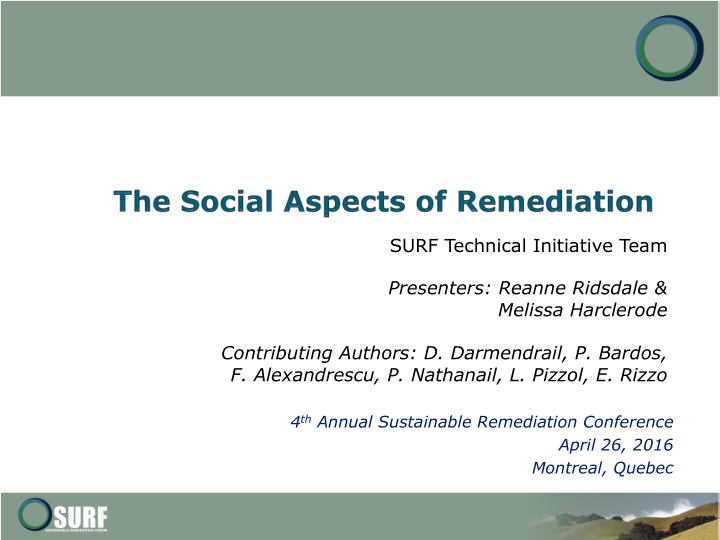



SURF Technical Initiative Team Presenters: Reanne Ridsdale & Melissa Harclerode Contributing Authors: D. Darmendrail, P. Bardos, F. Alexandrescu, P. Nathanail, L. Pizzol, E. Rizzo 4 th Annual Sustainable Remediation Conference April 26, 2016 Montreal, Quebec
Technical Initiative Team Research Problem & Goal What is the Social Dimension? Methods Findings: Main Societal Impact Categories Assessment Techniques Case Studies Opportunities & Challenges Closing Thoughts
Professional Organizations Academics SURF (USA) University of Venice, Italy SURF-Canada University of Brighton, UK SURF-Italy University of Nottingham, UK SURF-Taiwan University of Saskatchewan, Canada SURF-UK Montclair State University, Policy Makers/Regulators New Jersey, USA Common Forum/ ICCL University of Illinois at International Organization Chicago, USA for Standardization (ISO) University KU Leuven, Working Group 12 of TC190/ Belgium SC7
Lack of ‘success stories’ No presence of indicators or tools? Issues of addressing social aspects through engineering lens Lack of interdisciplinary teams Find existing social indicators and tools and apply them to SR.
1. Common Practice social dimension of ‘Sustainability’ assessed among various countries and organizations Looking to other disciplines 2. Methodologies & Case Studies quantitatively and qualitatively evaluate societal impacts
1. Social-Individual (4) (2) 2. Socio-Institutional (1) 3. Socio-Economic (3) 4. Socio-Environmental (Reddy ¡et ¡al., ¡2014) ¡
Document Review SuRF Working Papers Literature Review Discussions within Networks Social Scientist input Case Study Review
Ten Main Impact Categories Common Tools & Methods
2. Health and Safety 1 . Stakeholder Collaboration *on-site worker & community
4. Alleviate Undesirable 3. Benefits Community at Large Community Impact Improve Quality of Life Neighborhood/Locality Scale social and human capital noise reuse of treated media/ odor materials congestion redevelopment of the business disruptions property (reuse of the site) compromising local heritage Increase of property value and cultural concerns (site and surroundings)
5. Economic Vitality 6. Social Justice increased housing availability contracting locally employment opportunities investing in new skill training and education reused brownfields for equitable use incorporating redevelopment
7. Regional and Global Societal 8. Value of Ecosystem Services Impacts and Natural Resources Capital
9. Risk-Based Land 10. Contribution to Local and Management and Remedial Regional Sustainability Solutions Policies and Initiatives distribute resources to renewable energy effectively address the site- climate change adaptation specific human health, regional land use policies environmental justice, and ecological restoration goals community issues associated resource consumption with contaminated sites
Understand and Identify: Social factors that may work in favor of or against 1. sustainable remediation Access to labour, publicity (buy in) Social factors and stakeholders that are affected by 2. remediation Perceived and actual risks, business access, demographics Stakeholders that are affected by remediation 3. Business owners, community members, government, NGOs
Interviews, Focus Groups, Social Network Analysis case study: Vega Science and Technology Park, Venice, Italy (Alexandrescu, et al., 2015) Survey Questions case study: Tar Ponds and Coke Ovens, Sydney, Nova Scotia, Canada (SURF Canada) Multi-Criteria Decision Analysis (MCDA) case study: Gunnar Mine and Mill Tailings Cover, Saskatchewan Research Council Pilot Project (Petelina et al., 2014) Ethnographic research A Civil Action
Pope et al. (2004) Achieve a particular outcome assessed based on TBL objectives • Encourage positive impacts • Fewer trade-offs and conflicts
A rating metric and an aggregation rule that combines individual ratings into a single overall score qualitative and quantitative metrics case studies: social sustainability evaluation matrix tool ( Reddy et al., 2014)
Monetized benefits to society vs. monetized costs to society of undertaking particular courses of action case studies: sustainable return on investment (Bohmholdt 2014) costs borne by society Evaluation - monetizing global impacts (Harclerode et al., 2013; In Press)
1. Sydney Tar Ponds, Nova Scotia, Canada 2. Closed Landfill, North-Eastern States, USA
Sydney Tar Ponds Closed Landfill Technique: Technique: Panel Recommendation to Sustainable Return on incorporate into assessment Investment (sROI) Contaminated Material: Contaminated Material: PAHs, Hyrdocarbons, PCBs, Polyethlene Terephthalate Dioxins, Heavy Metals Method: Method: Dig & Dump/Recycle Soil Capping, Water treatment & Capping End Use: End Use: Park & Public Space Park, Sports Facilities, Art Installations, & Playground
Opportunities, Challenges, Future Research, & Closing Thoughts
1. Meaningful Stakeholder Engagement 2. Risk Perception of Stakeholders 3. Trade-Offs Among Triple Bottom Line Dimensions
1. Value of Social Cost Metrics 2. Risk Perception of Reuse 3. Integrated and Objective-led Assessment Approach 4. Life-Cycle Assessment
The principle of Occam’s Razor (parsimony) (Hiroshi, 1997) should apply. It is better to be comprehensive in the coverage of social issues than to be sophisticated in the quantification of a few. Take advantage of available tools and experts. Have multi-disciplinary teams: Social Scientist, urban planner, economist, public outreach (NGO).
Reanne Ridsdale, M.A., B.A. Drridsdale@gmail.com Melissa Harclerode, ENV SP, PhD Candidate harclerodema@cdmsmith.com
Entire Team: D. Darmendrail: Common Forum/ICCL, Paris P. Bardos : r3 Environmental Technology Ltd, University of Brighton, SuRF UK F. Alexandrescu: University of Venice, Italy P. Nathanail: University of Nottingham, Land Quality Management Ltd, ISO working group, SuRF UK L. Pizzol: University of Venice, Italy E. Rizzo : University of Venice, SuRF Italy, FP7 European Project HOMBRE & TIMBRE
Recommend
More recommend